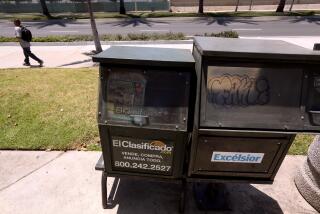Solid Support : Community Group Brings Police Division Into the Computer Age
- Share via
More than a decade into the computer age, many Los Angeles police officers still hammer out homicide reports on battered, archaic typewriters, suffering the indignities of hitting the “K” key and getting a comma, maybe, or the comma key when they want a five-space indentation.
But not at the Devonshire Division in Northridge.
There, there are computers on nearly every desk, as well as top-of-the-line laser printers and a $3,000 telephone system that dials neighbors when a break-in occurs down their street.
Devonshire officers who finish duty at 3 a.m. and have to be back in court a few hours later no longer shiver in jail cells or on a storage room floor--they curl up in Art Deco bunk beds with black and burgundy comforters.
No wonder visiting officers point excitedly around the division and blurt things like “Check this out!”
“People call this place ‘The Club,’ ” said Devonshire Senior Lead Officer Rick Gibby. And Devonshire officers call a 44-year-old Granada Hills mother, wife and dental office manager when they remember the old days and want to say thanks.
In two years, Becky Lohnes Leveque and her group SOLID (Supporters Of Law enforcement In Devonshire) have helped make the division probably the most technologically advanced in the city, according to LAPD spokesman Officer Ray Sua.
In addition to the 60 or so computers--”You may have one per whole division” in other parts of the city, Sua said--there are cellular telephones, a paper-shredder, answering machines and night-vision goggles.
“We’re asking (police) to risk their lives for us,” Leveque said. “The question people should ask themselves is: ‘How can we help?’ ”
It’s a question the energetic mother of three admits she didn’t often consider until late 1990, when a burglar smashed her dining room window and made off with her 16-year-old son’s precious collection of baseball cards.
She was furious.
“But I thought: ‘You have a full-time job. You have three kids. What can you do?’ ”
By the next spring the same son had encountered prowlers at the house and a neighbor’s home had been burglarized. Leveque decided she had to do something.
She organized a community meeting on police issues, delivering invitations door-to-door. She expected a couple dozen families to show; 500 came instead.
As Leveque began rallying her neighbors and forming the coalition that would eventually become SOLID, she began meeting with officials at the Devonshire Division and seeing how antiquated their equipment was.
“Most people assume that every division is computerized,” she said. “That’s how it is in the movies.”
Instead, the six senior lead officers at Devonshire--in charge of community policing programs--shared one phone and one desk. The first one in each morning got them both.
Officers would cannibalize one typewriter to keep another in service.
“It was ridiculous,” Leveque said.
Soon, SOLID was sending out fliers that listed equipment the division needed. People would donate $5 or $10 or offer an old desk or file cabinet. One man rounded up some 40 personal computers when his company upgraded its system. Another donated $3,000 worth of sand for graffiti removal.
Meanwhile, SOLID joined the six senior lead officers as they worked to implement community policing programs mandated--but not funded--by the department.
After just over two years of organizing, there are upward of 11,000 people involved in Neighborhood Watch, volunteer surveillance and graffiti-removal programs.
Members of SOLID also wash the bedding from the bunk room and pay the division’s cellular phone bills.
“It’s effect has been not only to equip us with things we need, but to further connect the police with the community,” said Devonshire Capt. Vance Proctor.
It’s not an attitude change in the west Valley that has helped SOLID grow from an angry brainstorm to one of the most effective police support organizations in Southern California, Leveque said. The anger and frustration with mindless violence were well-entrenched by 1992.
What was missing was a framework that allowed a working wife and mother of three--and 11,000 other people--to contribute.
“You don’t need bigwigs,” Leveque said. “Take it to the people.”
More to Read
Sign up for Essential California
The most important California stories and recommendations in your inbox every morning.
You may occasionally receive promotional content from the Los Angeles Times.













